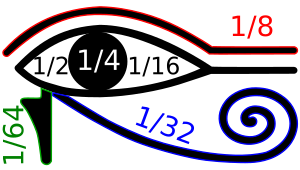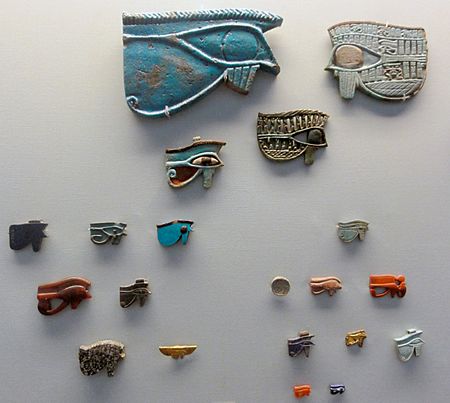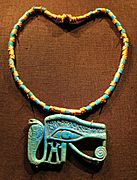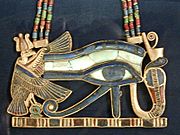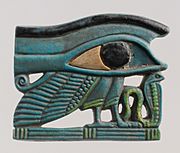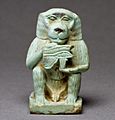Eye of Horus facts for kids
The Eye of Horus was a very important symbol in ancient Egypt. It stood for protection and royal power. It was linked to the gods Ra and Horus. Sometimes, it also represented the moon. The way the moon changed shape was like the eye getting hurt and then healed. Experts on Egypt often call this symbol the wedjat eye.
People used the Eye of Horus a lot for amulets. It was popular from the Old Kingdom (around 2686–2181 BC) until the Roman period (30 BC – 641 AD). You could see this symbol on carved stone slabs called stelae. It was also painted on the front of boats. People in nearby lands like Syria, Canaan, and especially Nubia also started using this symbol.
Contents
What the Eye of Horus Means
The Eye of Horus comes from ancient Egyptian stories. In one myth, the god Set hurt or destroyed one of Horus's eyes. Another god, like Thoth, then helped heal or bring back the eye. Horus later gave this healed eye to his father, Osiris, who had died. The eye's power helped Osiris stay alive in the afterlife.
Horus the Sky God
Horus was an ancient Egyptian sky god. He was often shown as a falcon. Sometimes, he looked like a human with a falcon's head.
The Eye of Horus symbol looks like a human or falcon eye. It often has an eyebrow and a dark line behind the eye. There's also a mark on the cheek below the eye. A line extends from the eye downwards and then curls. The cheek mark looks like the markings on many falcons. Some experts think the curling line comes from the facial markings of a cheetah. Egyptians thought cheetah spots looked like stars in the sky.
The "mirror image" of the Eye of Horus, which is the left eye, stood for the moon. It was also linked to the god Tehuti (Thoth).
How the Eye Was Used
The Eye of Horus was used in offerings to the gods in temples. It was also part of funeral rituals.
Pairs of Horus eyes were painted on coffins. This happened during the First Intermediate Period (around 2181–2055 BC) and the Middle Kingdom (around 2055–1650 BC).
Eye Amulets
Small charms called wedjat eye amulets first appeared in the late Old Kingdom. They were made until Roman times. Ancient Egyptians were often buried with amulets. The Eye of Horus was one of the most popular types. It is one of the few amulets found on mummies from the Old Kingdom. It stayed popular for over two thousand years.
Until the New Kingdom, funeral wedjat amulets were usually placed on the chest. During and after the New Kingdom, they were often put over the cut where organs were removed during mummification.
Wedjat amulets were made from many materials. These included Egyptian faience, glass, gold, and shiny stones like lapis lazuli. Their shapes also changed a lot. These amulets could be right or left eyes. They could be openwork, part of a flat piece, or just an outline of an eye. In the New Kingdom, more detailed forms appeared. A uraeus (a rearing cobra) could be at the front of the eye. The back spiral could become bird tail feathers. The cheek mark might look like a bird's leg or a human arm.
The eye symbol could also be part of bigger jewelry. It was often combined with other protective symbols. These included the ankh and djed signs. Starting in the 13th century BC, glass beads with eye-like spots were strung with wedjat amulets. This might be where the modern nazar comes from. A nazar is a bead meant to protect against the evil eye.
Sometimes, temporary amulets were made for protection. This happened in dangerous times, like during illness or childbirth. Old spells often told people to draw the wedjat eye on linen or papyrus. This drawing would then act as a temporary amulet.
-
Wedjat amulet with a cobra, Cairo Museum
Eye of Horus in Math
In ancient Egypt, the Eye of Horus was used in their measurement system. It showed how to write fractions. The full eye represented the number one (1). This was made up of parts: 1/2 + 1/4 + 1/8 + 1/16 + 1/32 + 1/64. Each part of the eye stood for a different fraction.
- 1/2 was shown by the right side of the eye, like a nose. It stood for smell.
- 1/4 was shown by the pupil. It stood for sight or light.
- 1/8 was shown by the eyebrow. It stood for thought.
- 1/16 was shown by the left side of the eye, like an arrow pointing to the ear. It stood for hearing.
- 1/32 was shown by a curved tail. It stood for taste, like wheat growing.
- 1/64 was shown by a leg touching the ground. It stood for touch.
Images for kids
-
Amulet from the tomb of Tutankhamun, 14th century BC. It shows the Eye of Horus under a moon symbol.
-
A small statue of Thoth as a baboon. He is holding the wedjat eye, from the 7th to 4th century BC.
-
A painting from the tomb of Pashedu, 13th century BC. It shows the Eye of Horus giving incense to the god Osiris.
See also
 In Spanish: Ojo de Horus para niños
In Spanish: Ojo de Horus para niños


